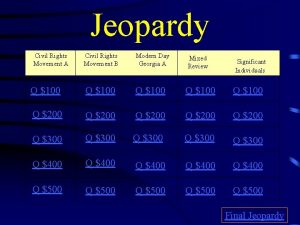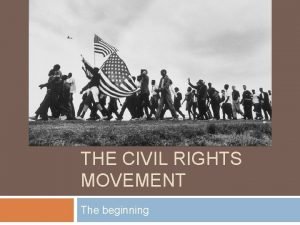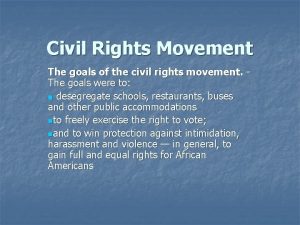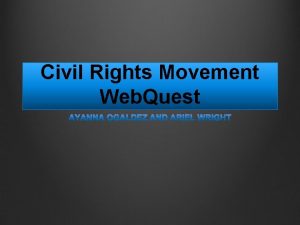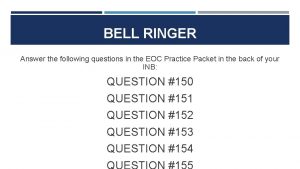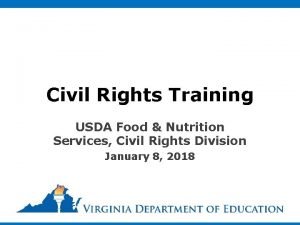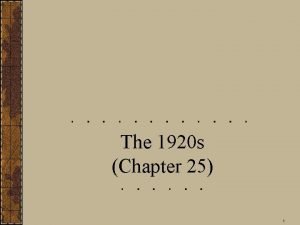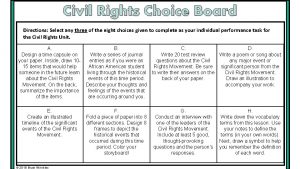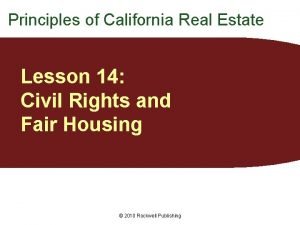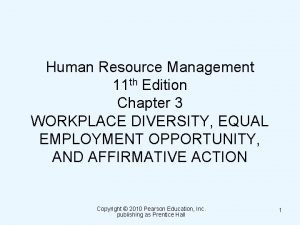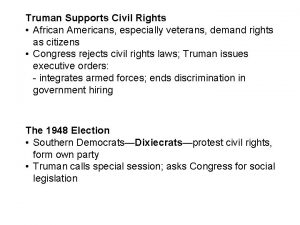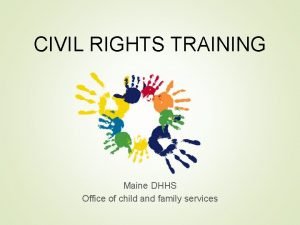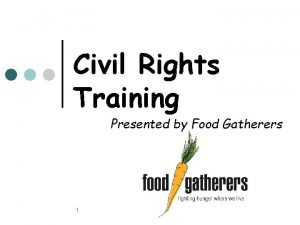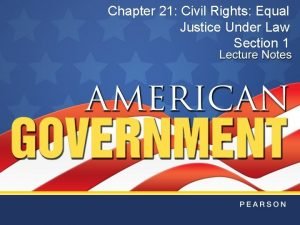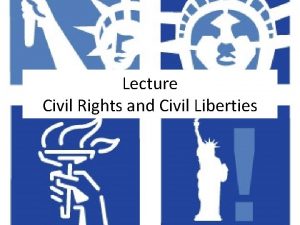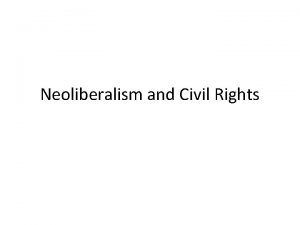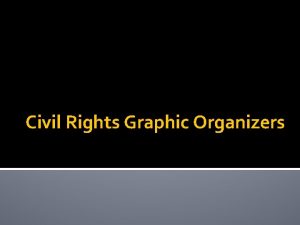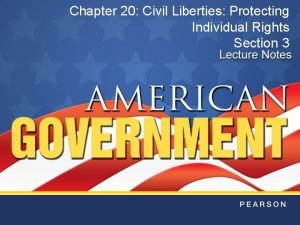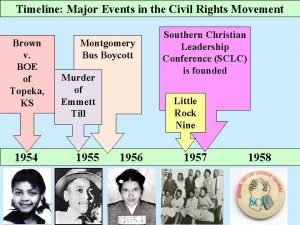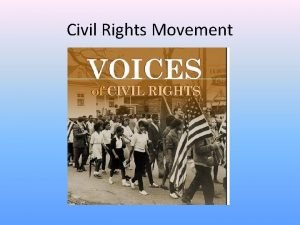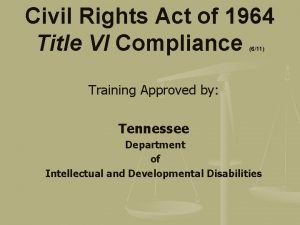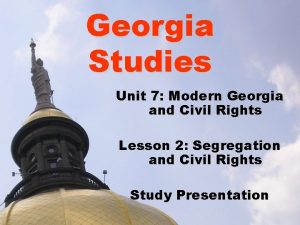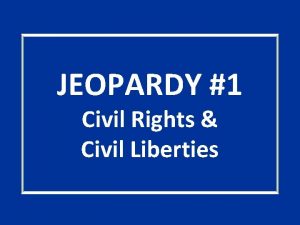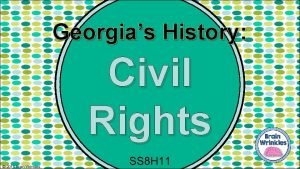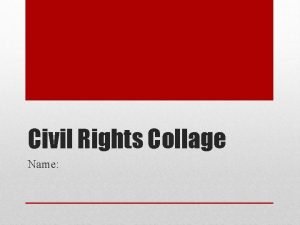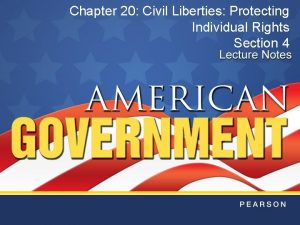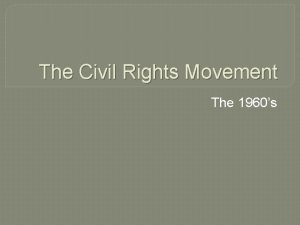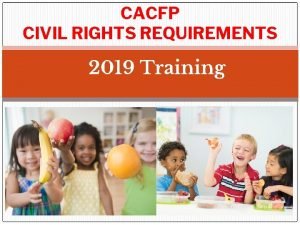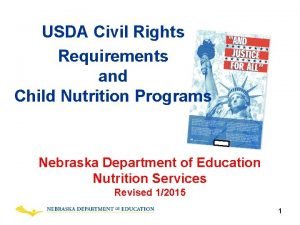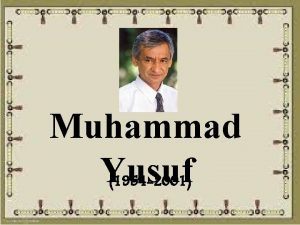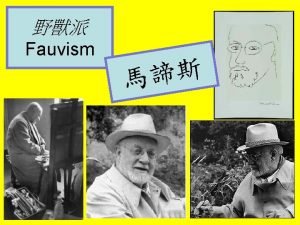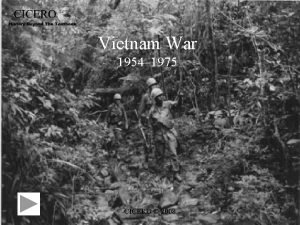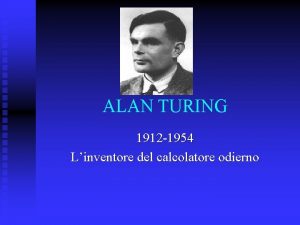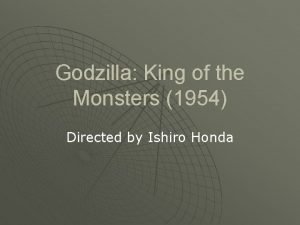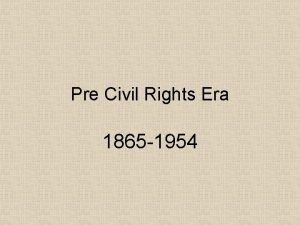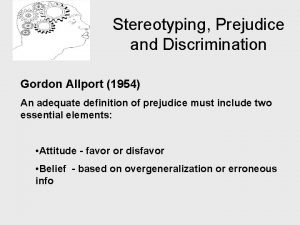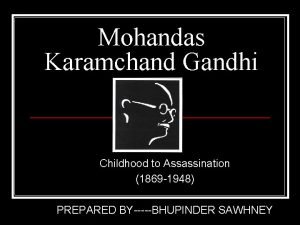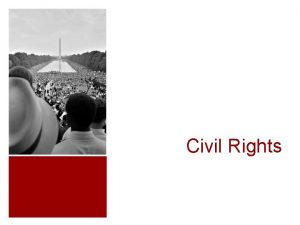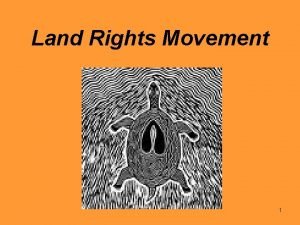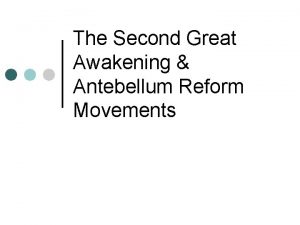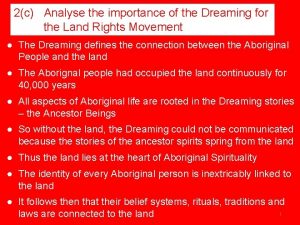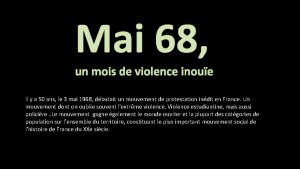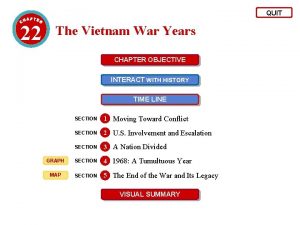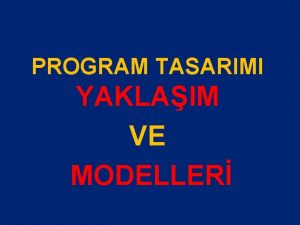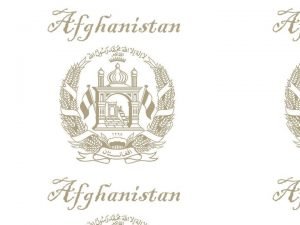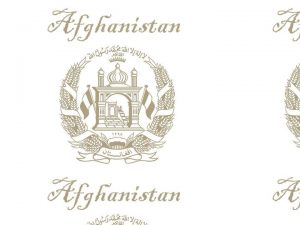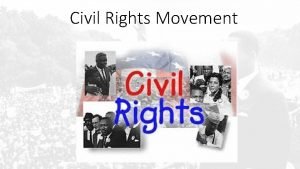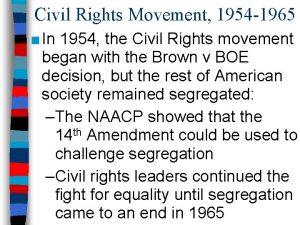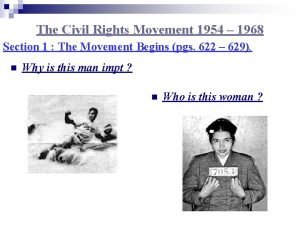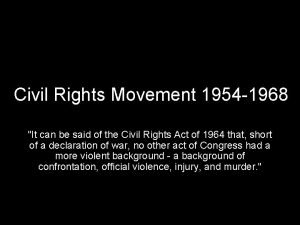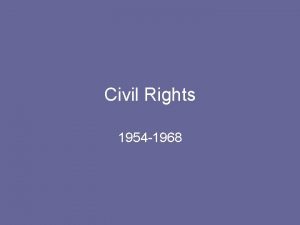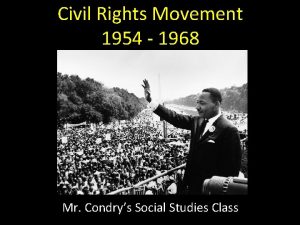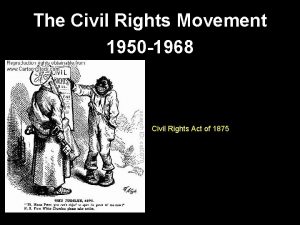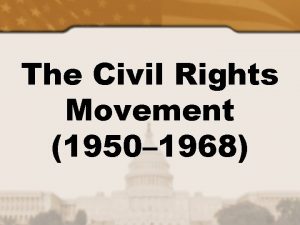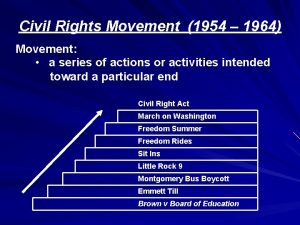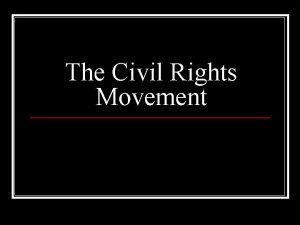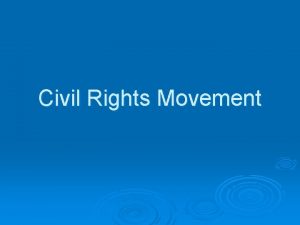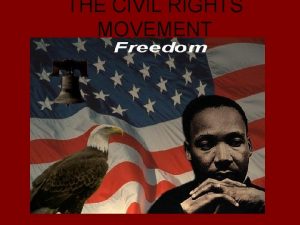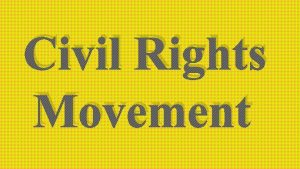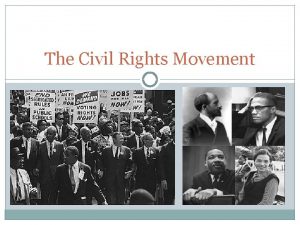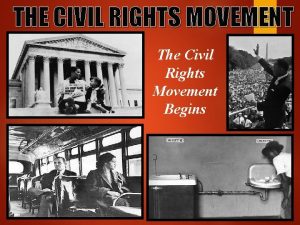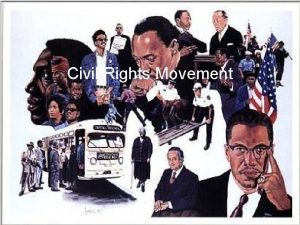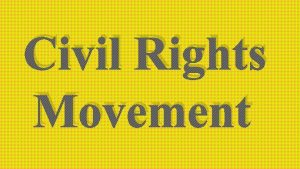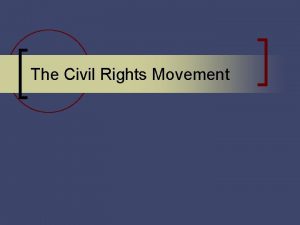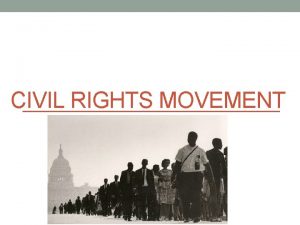The Civil Rights Movement 1954 1968 l In
















































































- Slides: 80

The Civil Rights Movement 1954 - 1968

l. In the 1950 s and 1960 s African Americans made major strides. l. They began by challenging segregation in the South. l. In Montgomery bus boycott, Martin Luther King Jr. achieved national and worldwide recognition.

The Origins of the Movement l The African American civil rights movement began after Rosa Parks refused to give her seat on a bus to a white man. l An organized boycott of the bus system was just the beginning as African Americans demanded equal rights.

l In 1896 the Supreme Court had declared segregation legal in Plessy v. Ferguson. l This ruling had established a separate-but-equal doctrine making laws segregating Africans Americans legal as long as equal facilities were provided. l Jim Crowe laws segregating African Americans and whites were common in the South after the Plessy v. Ferguson decision.

l In places without segregation laws such as the North, there was de facto segregation by custom and tradition. l The civil rights movement had been building for a long time. l Since 1909, the National Association for the Advancement of Colored People (NAACP) had supported court cases intended to overturn segregation. l It provided financial support and lawyers to African Americans.

l In 1935 the Supreme Court ruled in Norris v. Alabama that Alabama’s exclusion of African Americans from juries violated their right to equal protection under the law. l In 1946 the Court ruled in Morgan v. Virginia that segregation on interstate buses was unconstitutional.

l African Americans gained political power as they migrated to Northern cities where they could vote. l African Americans voted for politicians who listened to their concerns on civil rights issues, resulting in a strong Democratic Party.

The Push for Desegregation l During WWII African American leaders began to use their new political power to demand more rights. l In factories that held government contracts and increased opportunities for African Americans in the military.

l In Chicago in 1942, James Farmer and George Houser founded the Congress of Racial Equality (CORE). l CORE began using sit-ins a form of protest first used by union workers in 1930 s. l The sit-ins resulted in integration of many restaurants, theaters, and other public facilities in Chicago, Detroit, Denver and Syracuse.

The Civil Rights Movement Begins l When African Americans returned from WWII they had hoped for equality. l When this did not occur the civil rights movement began as African Americans planned protests and marches to end prejudice.

Brown v. Board of Education l After WWII the NAACP continued to challenge segregation in the courts. l From 1939 to 1961 the NAACP’s chief counsel and director of its Legal Defense and Education Fund was the brilliant African American attorney Thurgood Marshall.

l After WWII Marshall focused on his efforts on ending segregation in public schools. l In 1954 Supreme Court decided to combine several different cases and issue a general ruling on segregation in schools. l In 1954 the Supreme Court decided to combine several different cases and issue a general ruling on segregation in schools.

l One of the cases involved a young African American girl named Linda Brown who was denied admission to her neighborhood school in Topeka, Kansas because of her race. l She was told to attend an allblack school across town. l With the help of her parents and the NAACP they sued the Topeka school board.

l On May 17, 1954, the Supreme Court ruled unanimously in the case of Brown v. Board of Education of Topeka, Kansas that segregation in public schools was unconstitutional and violated the equal protection clause of the Fourteenth Amendment. l Chief Justice Earl Warren summed up the Court’s decision when he wrote: “In the field of public education the doctrine of separate but equal has no place. Separate educational facilities are inherently unequal. ”

The Southern Manifesto l The Brown decision marked a dramatic reversal of the ideas expressed in the Plessy v. Ferguson case. l Brown v. Board of Education applied only to public schools but the ruling threatened the entire system of segregation. l Although it convinced many African Americans that the time had come to challenge other forms of segregations, it also angered many white Southerners, who became even more determined to defend segregation, regardless of what the Supreme Court ruled.

l Although some school districts in border states integrated their in compliance with the Court’s ruling, anger and opposition was a far more common reaction. l In Washington, D. C. Senator Harry F. Byrd of Virginia called on Southerners to adopt “massive resistance” against ruling. l Across the South hundreds of thousands of white Americans joined citizens’ councils to pressure their local governments and school boards into defying the Supreme Court.

l In 1956 a group of 101 Southern members of Congress signed the Southern Manifesto which denounced the Supreme Court’s ruling as a clear abuse of judicial power and pledged to use all lawful means to reverse the decision.

The Montgomery Bus Boycott l On the day Rosa Parks appeared in court, the Women’s Political Council led African Americans in a boycott against the Montgomery bus system. l The Montgomery Improvement Association was created to run the boycott and negotiate with city leaders to end segregation.

l Dr. Martin Luther King Jr. was elected to head The Montgomery Improvement Association he called for a nonviolent passive resistance approach to end segregation and racism. l The boycott of the bus system continued for over a year as African Americans walked or participated in carpools. l In December 1956, the U. S. Supreme Court declared Alabama’s laws requiring segregation on buses to be unconstitutional.

African American Churches l Martin Luther King Jr. was not the only prominent minister in the bus boycott. l Many other leaders were African American ministers. l The boycott could not have succeeded without the support of the African American churches in the city.

l After the Montgomery bus boycott demonstrated that nonviolent protest could be successful, African American ministers led by King established the Southern Christian Leadership Conference in 1957. l The SCLC set out to eliminate segregation from American society and to encourage African Americans to register to vote. l Dr. King served as the SCLC’s first president. l Under his leadership the organization challenged segregation at the voting booths, and in public transportation, housing, and public accommodations.

l African American churches served as forums for many of the protest and planning meetings. l The churches also mobilized many of the volunteers for specific civilrights campaigns. l African American ministers led by Dr. Martin Luther King Jr. established the SCLC which was set up to eliminate segregation from American society and encouraged African Americans to vote.

Eisenhower and Civil Rights l President Eisenhower became the first president since Reconstruction to send federal troops into the South to protect African Americans and their constitutional rights.

l In Little Rock, Arkansas Governor Orval Faubus ordered the National Guard to prevent African American students from entering the Little Rock High School. l President Eisenhower demanded that the troops be removed. l The governor withdrew the troops but left the school to the angry mob.

l Two African Americans were beaten and many windows of the school were broken. l Eisenhower ordered the United States Army to surround the school and the students were escorted into the building. l The troops remained the entire school year.

New Civil Rights Legislation l The same year that the Little Rock crisis began, Congress passed the first civil rights law since Reconstruction. l The Civil Rights Act of 1957 was intended to protect the right of African Americans to vote. l President Eisenhower believed firmly in the right to vote and he viewed it as his responsibility to protect voting rights.

l In 1964 Dr. Martin Luther King Jr. at the age of 35 was the youngest person ever to receive the Nobel Peace Prize for his works toward civil rights.

The Sit-In Movement l In 1960 four African Americans staged a sit-in at a Woolworth’s whites- only lunch counter. l This led to a mass movement for civil rights. l Soon sit-ins were occurring across the nation. l Within two months sit-ins had spread to 54 cities in 9 states.

l The effects the sit-in movement had was it got the nation’s attention and gave people a way to get involved in the civil rights movement. l Students like Jesse Jackson from North Carolina Agricultural and Technical College felt that sit-ins gave them power to change things.

SNCC l As sit-ins became more popular, it was necessary to choose a leader to coordinate the effort. l Ella Baker executive director of the SCLC urged students to create their own organization. l The students formed the Student Nonviolent Coordinating Committee (SNCC).

l Among SNCC’s early leaders were Marion Barry who later served as mayor of Washington, D. C. and John Lewis who later became a member of Congress. l African American college students from all over the South made up the majority of SNCC’s members although many whites also joined.

l Robert Moses, an SNCC volunteer from New York, pointed out that most of the civil rights movement was focused on urban areas, and rural Americans needed help as well. l When they went South, SNCC volunteers had their lives threatened and others were beaten. l In 1964 three SNCC workers were murdered as they tried to register African Americans to vote.

l SNCC organizer Fannie Lou Hamer was arrested in Mississippi after encouraging African Americans to vote. l While in Jail she was beaten by police. l Later she helped to organize the Mississippi Freedom Democratic Party. l She challenged the legality of the segregated Democratic Party at the 1964 Democratic Convention.

l In 1961 CORE leader Jessie Farmer asked teams of African Americans and whites to travel into the South to draw attention to the South’s refusal to integrate bus terminals. l The teams became known as the Freedom Riders. l In May 1961 the first Freedom Riders boarded several southbound interstate buses.

l When buses carrying them arrived in Anniston, Birmingham, and Montgomery, Alabama, angry white mobs attacked them. l The mobs slit the bus tires and threw rocks at the windows. l In Anniston, someone threw a firebomb into one bus, although fortunately no one was killed. l In Birmingham the riders emerged from a bus to face a gang of young men armed with bats, chains and lead pipes.




l The head of the police in Birmingham, Public Safety Commissioner Theophilus Eugene “BULL” Conner explained that there had been no police at the bus station because it was Mother’s Day, and he had given many of the police officers off. l FBI evidence later showed that Connor had contacted the Local KKK and told them he wanted the Freedom Riders beaten until ‘it looked like a bulldog got a hold of them. ”

l The violence in Alabama made national news shocking many Americans. l The attack on the Freedom Riders came less than four months after President Kennedy took office. l President Kennedy was compelled to do something about the violence in Alabama.

John F. Kennedy and Civil Rights l During JFK’s presidential campaign in 1960 he supported the civil rights movement, which resulted in African American votes that helped him narrowly win the race. l Once in office, President Kennedy became cautious on civil rights realizing that in order to get other programs passed through Congress he would have to avoid new civil rights legislation.

l President Kennedy and his brother Robert actively supported the civil rights movement. l Robert helped African Americans register to vote by having lawsuits filed throughout the South. l President Kennedy created the Committee on Equal Opportunity to stop the federal bureaucracy from discrimination against African Americans when hiring and promoting people.

l In 1962 James Meredith an African American Air Force veteran tried to register at the segregated University of Mississippi. l Meredith was met with the governor blocking his path. l President Kennedy ordered 500 federal marshals to escort Meredith to the campus.

l A full scale riot broke out with 160 marshals being wounded. l The army sent in thousands of troops. l For the remainder of the year, Meredith attended classes under federal guard until he graduated the following August.

The Civil Rights of 1964 l Alabama Governor George Wallace blocked the way for two African Americans to register for college at the University of Alabama, President Kennedy appeared on national television to announce his civil rights bill. l He stayed until federal marshals ordered him to move.


George Wallace blocks the entrance to Foster Auditorium at the University of Alabama in 1963 as a National Guardsman asks him to step aside. Wallace symbolically blocked the entrance of the first registered African American students after mandatory school desegregation was enacted by the federal government.

l The following day a white segregationist murdered Medger Evers a civil rights activist (Byron De La Beckwith) in Mississippi.

l Martin Luther King Jr. wanted to pressure Congress to pass Kennedy’s civil rights bill through. l On August 28, 1963 King led 200, 000 demonstrators of all races to the nations’ capital and staged a peaceful rally.

l Opponents of the Civil rights bill did whatever they could to slow the procedure to pass it. l The bill could easily pass in the House of Representatives but it faced difficulty in the Senate. l Senators could speak for as long as they wanted while debating a bill. l A filibuster occurs when a small group of senators take turns speaking and refuse to stop the debate to allow the bill to be voted on.

l Today a filibuster can be stopped if at least three-fifths of the Senate (60 senators) vote for cloture a motion in which cuts off debate and forces a vote. l In 1960 a cloture had to be two-thirds or 67 senators. l The minority of senators opposed to the bill could easily prevent it from passing into law.

l After Kennedy’s assassination. President Johnson committed himself to getting Kennedy’s program including the civil rights bill through Congress. l The Civil Rights Act of 1964 gave the federal government broad power to stop racial discrimination in the segregation in public places, to bring lawsuits to end school segregation and to require employers to end discrimination in the workplace.

l The Civil Rights Act of 1964 did little to guarantee the right to vote. l Many African Americans voters were attacked, beaten and killed. l Bombs exploded in many African American businesses and churches.

Birmingham Church Bombings l It was called "Bombingham. " And the title was not meant to be funny. Things were so bad in Birmingham, Alabama, during the early 1960 s, that everyone, black or white, risked their lives just by walking through the city's streets. A bomb could go off at anytime.

l From 1950 to 1960, dozens of bombings were committed in Birmingham by unknown terrorists. Black homes or businesses were usually the targets of these explosions. l In most cases, the victims were alleged to have committed an offense against the rigid structure of white supremacy.

l The men responsible hid behind the cloak of secrecy, intimidation and the white robes of the oldest terrorist organization in the world, the Ku Klux Klan. l For the last 40 years, this epic pursuit of justice, which spanned eight Presidents, inched forward to a bitter end, while the aging families of the victims looked on in patient anguish. l But the terrible bombing of the Sixteenth Street Baptist Church on September 15, 1963, will never be forgotten.


l Dr. King decided it was time for another protest to protect African American voting rights. l The Twenty- Fourth Amendment ratified in 1964 helped somewhat by eliminating poll taxes or fees paid in order to vote in federal (but not state) elections.

l. The protest was staged in Selma, Alabama where African Americans were the majority of the population while only 3 percent were registered to vote. l Their march for freedom began in Selma and headed toward the state capitol in Montgomery. l Sheriff Jim Clark ordered 200 state troopers and deputized citizens to rush the peaceful demonstrators. l The brutal attack became known as Bloody Sunday and the nation saw the images on television





l On August 3, 1965 the House of Representatives passed the voting bill with Senate passing the bill the following day. l The Voting Rights Act of 1965 gave the attorney general the right to send federal examiners to register qualified voters bypassing the local officials who often refused to register African Americans. l This resulted in 250, 000 new African American voters and an increase in African American elected officials in the South.

l. Even with the passage of civil rights laws in the 1950 s and 1960 s racism or prejudice toward someone because of their race was common. l. The civil rights movement had resulted in many positive gains for African Americans but their economic and social problems were much more difficult to address.

l Race riots broke out in many American cities between 1965 and 1968. l A race riot in Watts a neighborhood in Los Angles lasted 6 days. l These riots occurred from allegations of police brutality.


l The worst of the riots occurred in Detroit when the U. S. Army was forced to send in tanks and soldiers with machine guns to gain control.

l The Kerner Commission was created to make recommendations that would prevent further urban riots. l It concluded that the problem was white society and white racism. l The commission suggested the creation of 2 million new jobs in inner cities and 6 million new units of public housing. l However with the massive spending in the Vietnam War, President Johnson never endorsed the recommendation.

l By the mid-1960 s Martin Luther King Jr. was criticized for his nonviolent strategy because it had failed to improve the economic conditions of African Americans. l As a result he began focusing on economic issues affecting African Americans. l The Chicago Movement was an effort to call attention to the deplorable housing conditions that many African Americans faced. l Dr. King and his wife moved into the slum apartment in an African American neighborhood in Chicago.

l Dr. King led a march through the white suburb of Marquette Park to demonstrate the need for open housing. l Mayor Richard Daley had police protect the marchers and Daley met with King to propose a new program to clean up the slums.

l After 1965 many African Americans began to turn away from the nonviolent teachings of Dr. King. l They sought new strategies which included self-defense and the idea that African Americans should live free from the presence of whites. l Young African Americans called for black power a term that had many different meanings.

l SNCC leader Stokely Carmichael black power meant they should control social, political, and economic direction of their struggle for equality.

l Black Power, Carmichael said, was a “call for black people to begin to define their own goals… an lead their own organizations. l Dr. King urged him to stop using the phrase he believed it would provoke African Americans to violence and antagonize whites. l Carmichael refused and urged the SNCC to stop recruiting whites and focus on developing African. American pride.

l Black power stressed pride in the African American culture and opposed cultural assimilation or the philosophy of incorporating different racial or cultural groups into the dominant society. l These ideas were popular in poor urban neighborhoods although Dr. King and many African Americans leaders were critical of black power.

l The formation of the Black Panthers was the result of a new generation of militant African American leaders preaching black power, black nationalism, and economic self-sufficiency. l The group believed that a revolution was necessary to gain equal rights.

l In the early 1960 s Malcolm X had become a symbol of the Black Power movement. l Malcolm X was a member of the Nation of Islam known as the Black Muslims who believed that African Americans should separate themselves from whites and form their own selfgoverning communities.

l Malcolm X later broke from the Nation of Islam and began to believe an integrated society was possible. l In 1965 three members of the Nation of Islam shot and killed Malcolm X. l He would be remembered for his view that although African Americans had been victims in the past they did not have to allow racism to victimize them now.

Assassination of Martin Luther King Jr. l Dr. King was assassinated by a James Earl Ray on April 4, 1968 in Memphis, Tn.

l The Reverend Ralph Abernathy who had served as a trusted assistant to Dr. King for many years led the Poor People’s Campaign in King’s absence. l The goals of the Poor People’s Campaign were to promoted economic advancement for all impoverish Americans.
 Civil rights and civil liberties webquest
Civil rights and civil liberties webquest Civil rights movement jeopardy
Civil rights movement jeopardy The civil rights movement
The civil rights movement Civil rights movement goal
Civil rights movement goal Civil rights movement essential questions
Civil rights movement essential questions Civil rights movement vocabulary
Civil rights movement vocabulary Rosa parks mother
Rosa parks mother Civil rights movement webquest
Civil rights movement webquest Civil rights bell ringers
Civil rights bell ringers Usda civil rights training
Usda civil rights training Chapter 14 postwar prosperity and civil rights
Chapter 14 postwar prosperity and civil rights Sibley commission definition
Sibley commission definition Civil rights choice board
Civil rights choice board Unruh civil rights act real estate
Unruh civil rights act real estate Kerner commission apush
Kerner commission apush Title vii of the civil rights act
Title vii of the civil rights act Truman supports civil rights
Truman supports civil rights Civil rights in child nutrition programs
Civil rights in child nutrition programs Civil rights training child nutrition programs
Civil rights training child nutrition programs What did sncc accomplish and how
What did sncc accomplish and how Federally protected classes
Federally protected classes Chapter 21 civil rights equal justice under law
Chapter 21 civil rights equal justice under law Define civil rights
Define civil rights Title vii of the civil rights act
Title vii of the civil rights act Characteristics of civil rights
Characteristics of civil rights Civil rights graphic organizer
Civil rights graphic organizer Chapter 20 civil liberties protecting individual rights
Chapter 20 civil liberties protecting individual rights Civil rights timeline of events
Civil rights timeline of events Civil rights movment
Civil rights movment Title vi of the civil rights act of 1964
Title vi of the civil rights act of 1964 Chapter 20 civil liberties protecting individual rights
Chapter 20 civil liberties protecting individual rights Unit 7 modern ga and civil rights
Unit 7 modern ga and civil rights Civil rights jeopardy
Civil rights jeopardy Civil rights cloze notes 1
Civil rights cloze notes 1 Civil rights collage
Civil rights collage Chapter 20 civil liberties protecting individual rights
Chapter 20 civil liberties protecting individual rights Civil rights sitins
Civil rights sitins Cacfp civil rights
Cacfp civil rights Civil rights in child nutrition programs
Civil rights in child nutrition programs Incident method
Incident method Ibm formula
Ibm formula Muhammad yusuf maylida
Muhammad yusuf maylida Henri matisse lydia
Henri matisse lydia Frida kahlo 1907 a 1954
Frida kahlo 1907 a 1954 Vietnam 1954
Vietnam 1954 1954
1954 Color 15111999
Color 15111999 Godzilla king of the monsters 1954
Godzilla king of the monsters 1954 1954 hemşirelik kanunu
1954 hemşirelik kanunu Ron hubbard 1954
Ron hubbard 1954 1954-1865
1954-1865 Hurricane morgan 1954
Hurricane morgan 1954 Fortran 1954
Fortran 1954 Ruby.jlt bridges
Ruby.jlt bridges 1949 cadillac series 62 4 door
1949 cadillac series 62 4 door Magnétoscope 1954
Magnétoscope 1954 1954
1954 Allport 1954
Allport 1954 Littoral water rights
Littoral water rights Positive and negative rights
Positive and negative rights Negative right
Negative right Moral duties
Moral duties Negative right
Negative right Positive rights vs negative rights
Positive rights vs negative rights Legal rights and moral rights
Legal rights and moral rights Negative right
Negative right Program of civil disobedience movement
Program of civil disobedience movement Civil right def
Civil right def Importance of the dreaming for the land rights movement
Importance of the dreaming for the land rights movement Women's rights movement
Women's rights movement The importance of the dreaming for the land rights movement
The importance of the dreaming for the land rights movement Bernie boston
Bernie boston Secouristes
Secouristes Chapter 22 section 4 1968 a tumultuous year
Chapter 22 section 4 1968 a tumultuous year Filiz vural
Filiz vural Tc 24 juin 1968 société distilleries bretonnes
Tc 24 juin 1968 société distilleries bretonnes Glanzer and cunitz
Glanzer and cunitz He is the author of icnofalangometrica
He is the author of icnofalangometrica Software crisis 1968
Software crisis 1968 1967 1968 1969 1970 1971 1972 1973 1974 1975 1976
1967 1968 1969 1970 1971 1972 1973 1974 1975 1976 1948 ilkokul programı
1948 ilkokul programı

